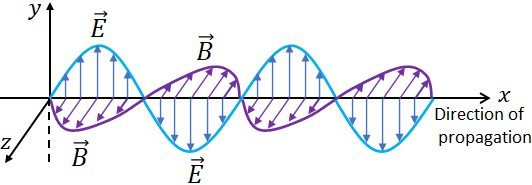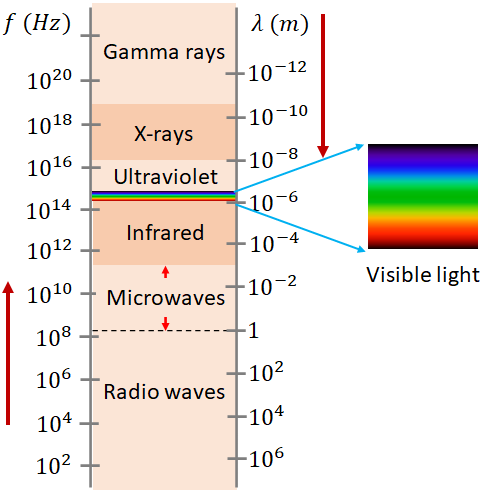Electromagnetic waves
Electromagnetic waves are the propagation of oscillating electric and magnetic fields. In an electromagnetic wave, the electric and the magnetic field are oscillating perpendicular to each other and also perpendicular to the direction of propagation of the wave. Since the fields are oscillating perpendicular to the direction of propagation, electromagnetic waves are transverse waves. Radio waves, microwaves, infrared light, visible light, ultraviolet light, X-rays and gamma rays are all electromagnetic waves.
Speed of an electromagnetic wave
By using Maxwell's equations, James Clark Maxwell, derived the speed of an electromagnetic wave.He showed that the speed of an electromagnetic wave, $c$ in free space is
$c=\dfrac{1}{\sqrt {\epsilon_0 \mu_0}}$
where $\epsilon_0$ and $\mu_0$ are the permittivity and permeability of free space.Upon substituting the values of $\epsilon_0$ and $\mu_0$, Maxwell found that $c$ is exactly equal to the speed of light in vacuum. i.e.,
$c=3.0\times 10^8 m/s$
Light is an electromagnetic wave
Speed of the electromagnetic waves is remarkably equal to the speed of the light in vacuum, and also later experiments proved that light is an electromagnetic wave.Wavelength, $\lambda$ and frequency, $f$ of an electromagnetic wave is related by,
$c=f\lambda$
where $c$ is the speed of light.Types of electromagnetic waves
Based on the wavelength or frequency, we classify electromagnetic waves into different types. They are radio waves, microwaves, infrared light, visible light, ultraviolet light, X-rays and gamma rays. Visible light has a wavelength range from 400 nm to 700 nm. This corresponds to the frequency (by f=c/ λ) range of 7.5x1014Hz to 4.3x1014Hz.If we put all the electromagnetic waves together according to their frequency or wavelength, we call that chart an electromagnetic spectrum. Visible light is a small part of the electromagnetic spectrum.

Energy in electromagnetic waves
Like all other waves, electromagnetic waves carry energy from one region of space to another. The energy of an electromagnetic wave is the energy stored in the electric field and the magnetic field of the wave.Energy per unit volume, also called energy density, $u$ of an EM wave is
$u=\dfrac{1}{2}\epsilon_0 E^2+\dfrac{1}{2}\dfrac{B^2}{\mu_0}$
In an EM wave, the energy is equally distributed among the electric and the magnetic field, therefore we can write$u=\epsilon_0 E^2$
or$u=\dfrac{B^2}{\mu_0}$
Intensity of an electromagnetic wave
Intensity of any wave is the energy the wave transport per unit time per unit area, where the area is measured perpendicular to the direction of propagation of the wave.Instantaneous intensity of an EM wave is
$I=\epsilon_0 cE^2$
If we find the average intensity, we will get$I=\dfrac{1}{2}\epsilon_0 cE_0^2$
where $E_0$ is the peak value of the electric field.